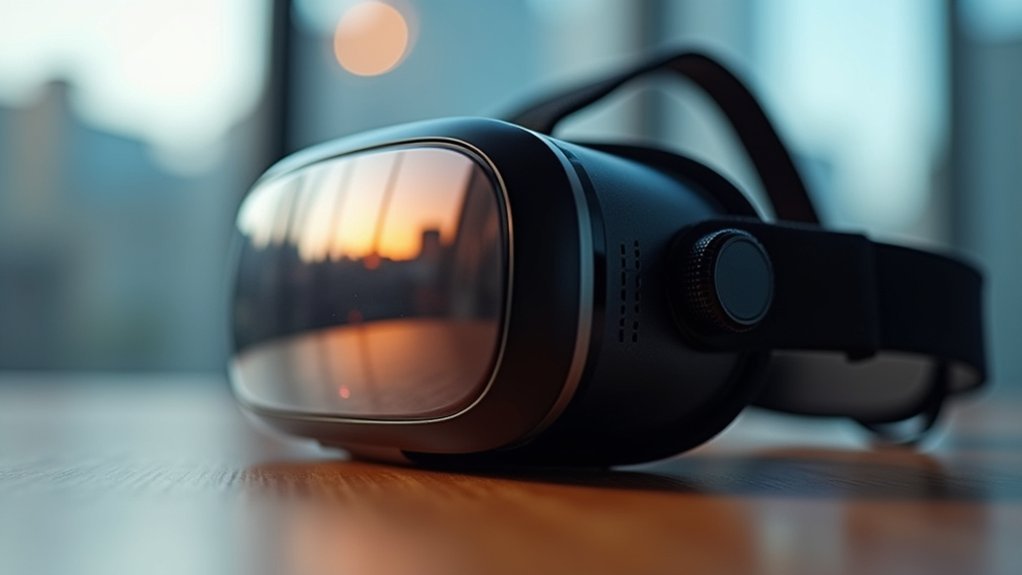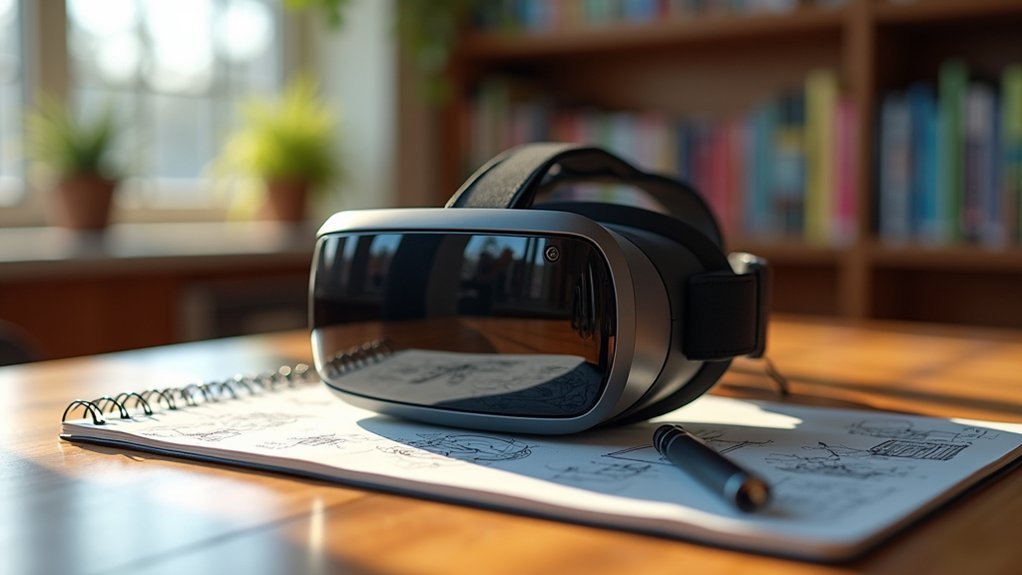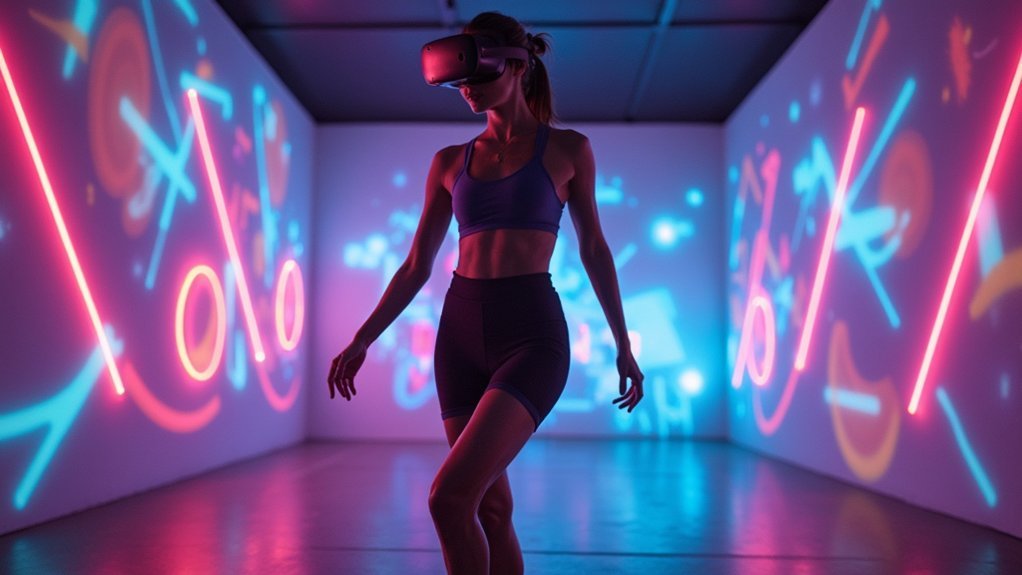To master VR headset PPD clarity, you’ll need to understand that higher PPD values above 40 deliver sharper visuals with reduced screen door effects. Set your headset to native resolution, enable super sampling, and maximize refresh rates for peak performance. Accurately measure and calibrate your IPD settings between 58-72mm, then position the headset snugly against your face to minimize distortion. Test clarity using Snellen charts in well-lit conditions. The following thorough strategies will elevate your visual experience considerably.
Understanding Pixels Per Degree Fundamentals in VR Technology
When you’re evaluating VR headset performance, Pixels Per Degree (PPD) serves as the most critical metric for determining visual clarity. PPD measures how many pixels appear within one degree of your field of view, directly impacting what you see in virtual environments.
Higher PPD values deliver sharper details and improved text readability, creating more immersive experiences that closely match what the human eye expects.
You’ll calculate PPD by dividing total horizontal pixels by the headset’s field of view. For example, 2000 pixels across a 100° field equals 20 PPD.
Most consumer headsets range between 20-35 PPD, while premium models like the Pimax Crystal exceed 50 PPD. Understanding this fundamental relationship between resolution and field of view helps you make informed decisions about headset performance and visual quality.
Calculating PPD Values Across Different VR Headset Models
While calculating PPD provides the foundation for understanding visual clarity, you’ll find that real-world values vary considerably across different VR headset models.
Understanding these differences helps you make informed decisions about which headset delivers the pixel density you need.
Here’s how different headsets stack up for clarity in VR:
- Consumer headsets typically deliver 20-35 PPD, providing decent visual quality for most applications.
- High-end models like the Pimax Crystal Super achieve 50-57 PPD through 3840×3840 horizontal pixels per eye.
- Premium options exceeding 40 PPD represent the top tier, dramatically reducing screen door effects.
When comparing models like the Quest Pro versus Pimax Crystal, you’ll notice significant PPD differences that directly impact your visual experience and immersion quality.
Optimizing Display Settings for Maximum PPD Performance

Beyond selecting a headset with high native PPD, you’ll need to configure your display settings properly to extract every bit of visual clarity from your device.
Start by setting your headset to its native resolution rather than lower settings that reduce PPD and create screen door effects. Enable super sampling features to boost effective resolution and enhance sharpness. Maximize your refresh rate to minimize motion blur during fast visuals.
Most importantly, calibrate your IPD settings to match your exact eye distance—incorrect IPD causes distorted images and compromises perceived clarity. Keep firmware updated since manufacturers regularly release improvements that enhance display performance.
These optimizations guarantee you’re experiencing the full PPD potential your headset offers.
Comparing High-End VR Headsets by PPD Specifications
Proper display configuration releases your headset’s potential, but choosing the right device starts with understanding how today’s premium models stack up against each other.
When evaluating high-end VR headsets, PPD becomes your most critical specification for determining visual quality.
The current market reveals clear performance tiers:
- Ultra-Premium (40+ PPD) – The Pimax Crystal Super leads with 50 PPD and 3840×3840 resolution per eye, delivering exceptional sharpness of the image.
- High-End (35-40 PPD) – Pimax Crystal Light offers 35 PPD at a more accessible price point.
- Standard Premium (20-35 PPD) – Most consumer VR headsets fall within this range.
Higher PPD values greatly reduce the screen door effect and enhance detail visibility.
You’ll notice markedly improved text readability and environmental detail sharpness when comparing these specifications across different models.
Adjusting IPD and Lens Distance for Enhanced Visual Clarity

Even with a headset boasting exceptional PPD specifications, you’ll achieve subpar visual clarity if your interpupillary distance (IPD) and lens positioning aren’t configured correctly.
Start by measuring your IPD using a ruler and mirror, or visit an optometrist for precision. Most VR headsets accommodate 58mm to 72mm ranges through adjustable settings.
Accurate IPD measurement is essential—use a ruler and mirror at home or get professional measurement from an optometrist.
Next, optimize lens distance by positioning the headset snugly against your face. This minimizes distortion and maximizes visual clarity. Incorrect spacing causes blurriness and discomfort, while proper alignment reduces eye strain during extended sessions.
Advanced headsets offer customizable lens options for fine-tuning both IPD and lens distance.
Take time to experiment with these settings—small adjustments dramatically impact your visual experience, transforming mediocre clarity into crisp, comfortable viewing that prevents fatigue.
Testing Methods to Evaluate PPD Quality and Sharpness
You’ll need reliable testing methods to accurately assess your VR headset’s PPD quality and visual sharpness.
Start with Snellen chart testing using a high-resolution chart at consistent distances to evaluate clarity under real-world reading conditions.
Master proper PPD measurement techniques by calculating your headset’s horizontal resolution divided by its horizontal field of view in degrees.
Snellen Chart Testing
When you’re evaluating VR headset clarity, the Snellen chart offers a standardized method that’s both accessible and reliable. This familiar eye chart, adapted for virtual environments, provides measurable data about your headset’s visual performance and PPD effectiveness.
To conduct proper Snellen chart testing, follow these essential steps:
- Calibrate your IPD settings – Verify your interpupillary distance is accurately configured before testing to achieve reliable clarity measurements.
- Test in well-lit conditions – Avoid low lighting that can distort your perception and skew results during evaluation.
- Document your smallest readable line – Record which line of letters you can clearly distinguish, as this indicates your headset’s sharpness and pixel density performance.
Compare results across different headsets to make informed decisions about visual quality and overall performance.
PPD Measurement Techniques
Calculating PPD requires a straightforward mathematical approach that divides your headset’s horizontal resolution by its horizontal field of view in degrees. For instance, a 2000-pixel display across 100° yields 20 PPD.
You’ll want to use high-resolution test images featuring fine details to assess clarity differences between headsets visually. Document your perceived sharpness at various distances while testing each headset.
Maintain a stable setup to prevent motion blur that could skew results. Consider using specialized measurement apps or software for objective PPD quantification rather than relying solely on subjective observations.
Modern headsets with eye tracking can provide additional data points for accuracy. Combine your findings with user feedback and reviews to validate real-world performance differences, ensuring thorough PPD evaluation across different VR systems.
Selecting the Right VR Headset Based on PPD Requirements
You’ll need to match your PPD requirements with different headset categories, from budget-friendly options around 20-25 PPD to professional-grade models exceeding 40 PPD.
Your budget directly impacts the visual quality you’ll experience, as higher PPD headsets like the Pimax Crystal Super with 50-57 PPD cost considerably more than standard consumer models.
Consider whether you’re using VR for casual gaming or professional applications like simulation training, since demanding use cases require the crystal-clear text and detail that only high-PPD headsets can deliver.
PPD Range Categories
Understanding PPD categories helps you make informed decisions when selecting a VR headset that matches your specific needs and budget.
Different PPD ranges offer distinct visual experiences, so knowing these categories guides your purchase decision.
1. Entry-Level (20-30 PPD) – Consumer VR headsets in this range provide basic immersion but may show noticeable screen door effects.
They’re suitable for casual gaming and entertainment.
2. Mid-Range (30-40 PPD) – These headsets deliver improved clarity and reduced screen door effects, making them ideal for regular VR users who want better visual quality.
3. High-End (40+ PPD) – Premium models like the Pimax Crystal Super offer exceptional clarity with 50-57 PPD ratings.
Higher PPD values greatly enhance text readability and approach real-life visual fidelity, perfect for professionals and enthusiasts.
Budget Vs Performance
Budget constraints greatly impact your VR headset selection, but PPD remains the most reliable indicator of visual quality across all price ranges.
You’ll find most consumer headsets deliver 20-35 PPD, while premium models like the Pimax Crystal Super exceed 50 PPD for exceptional clarity.
If you’re budget-conscious, consider the Pimax Crystal Light at 35 PPD—it balances performance with affordability effectively.
However, you’ll experience considerably better visual quality when targeting at least 40 PPD, which reduces screen door effects and enhances detail visibility.
Higher PPD headsets demand premium pricing, but they often provide better long-term satisfaction.
Carefully evaluate your specific clarity needs against budget limitations, especially if you’re using VR for gaming or professional applications requiring superior visual performance.
Professional Use Cases
When professional applications demand exceptional visual precision, selecting a VR headset with at least 40 PPD becomes critical for maintaining accuracy and reducing eye strain during extended work sessions.
Your choice of headset directly impacts productivity in specialized fields. For surgical training, CAD modeling, and industrial design, you’ll need crystal-clear visuals that eliminate guesswork and enhance detail recognition.
Consider these essential factors for professional use:
- Target 40+ PPD minimum – Guarantees text readability and eliminates screen door effects that distract from critical tasks.
- Evaluate optical design quality – Hybrid fresnel aspheric lenses provide superior clarity and comfort during prolonged sessions.
- Prioritize resolution specifications – Headsets like the Pimax Crystal offer 57 PPD with 3840×3840 per eye for maximum visual fidelity.
Higher PPD values translate to reduced visual fatigue and improved accuracy in professional environments.
Frequently Asked Questions
How to Make a VR Headset More Clear?
Adjust your headset’s interpupillary distance to match your eyes, clean lenses with microfiber cloth, guarantee snug fit, use prescription lens inserts if needed, and optimize lighting in your play area.
How to Increase VR Clarity?
You’ll boost VR clarity by adjusting your IPD settings properly, choosing headsets with higher resolution displays, using advanced lens designs, adding prescription lenses if needed, and keeping lenses clean.
What Is the Best VR Headset for Clarity?
You’ll find the Pimax Crystal Super offers the best clarity with its exceptional 50 PPD, followed by the Varjo Aero at 40 PPD for professional applications requiring superior visual fidelity.
What Is the Difference Between PPD and Resolution in VR?
Resolution counts total pixels in your display, while PPD measures pixels per degree of your field of view. You’ll find PPD better indicates actual visual clarity since it considers how much detail you’re seeing within your viewing angle.





Leave a Reply